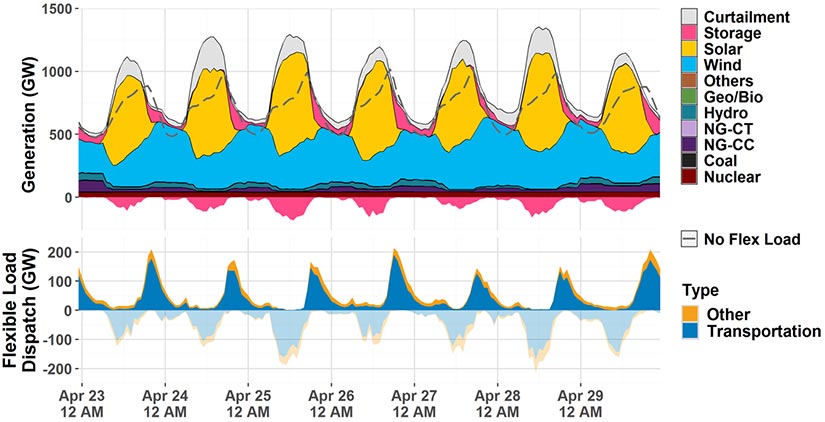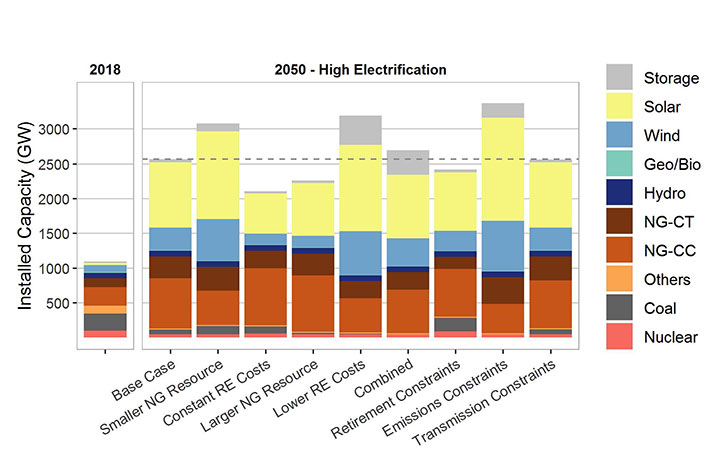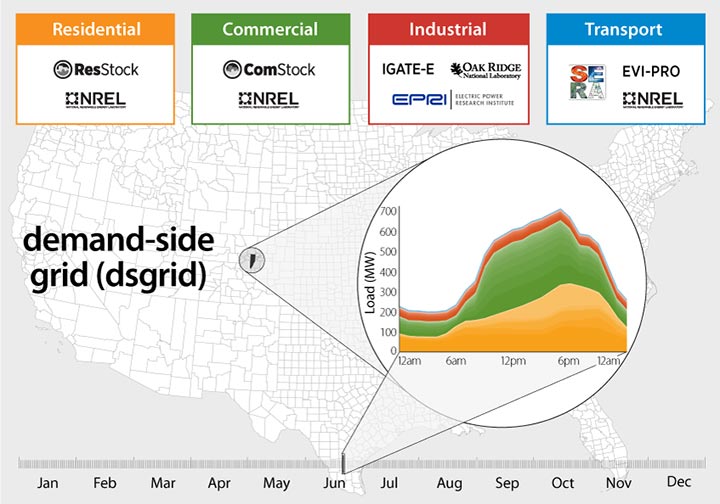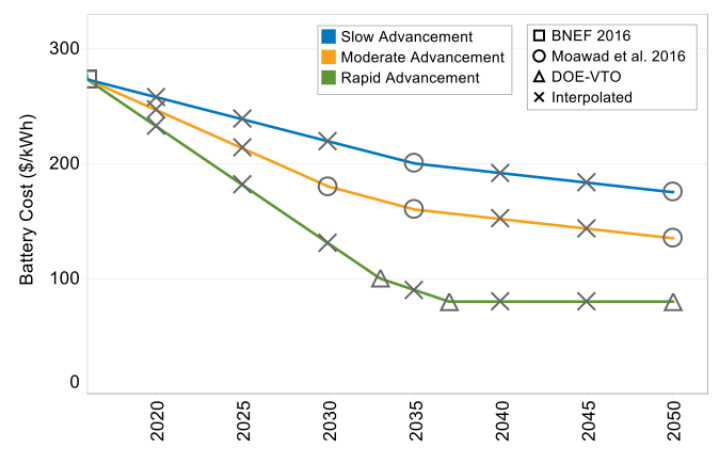Electrification Futures Study

Through the Electrification Futures Study (EFS), NREL explored the impacts of widespread electrification in all U.S. economic sectors.
For the multiyear study, NREL and its research partners—Electric Power Research Institute, Evolved Energy Research, Lawrence Berkeley National Laboratory, Northern Arizona University, and Oak Ridge National Laboratory—used multiple analytic tools and models to develop and assess electrification scenarios designed to quantify potential energy, economic, and environmental impacts to the U.S. power system and broader economy.
Publications
Detailed Grid Simulations

Released May 2021, the sixth and final report in the EFS series presents a power system operational analysis of high electrification scenarios. The analysis includes detailed grid simulations of future power systems and electricity demand in the year 2050 developed in earlier EFS reports, particularly the demand- and supply-side scenarios described in the second and fourth reports.
This report also presents an analysis of the potential role and value of flexible load, using assumptions of demand-side flexibility described in Electrification Futures Study: Methodological Approaches for Assessing Long-Term Power System Impacts of End-Use Electrification.
Technical Report: Electrification Futures Study: Operational Analysis of U.S. Power Systems with Increased Electrification and Demand-Side Flexibility
Informational Webinar: Recording and presentation slides
News Story: Flexible Loads and Renewable Energy Work Together in a Highly Electrified Future
Supply-Side Scenarios

Released January 2021, the fifth report in the EFS series presents analysis on the potential impacts of widespread electrification on the U.S. electricity system—specifically generation and transmission infrastructure investments, fuel use, system costs, and emissions. The report focuses on supply-side scenarios encompassing a wide range of future conditions under electrification levels developed in the second report. A scenario data viewer is available for those who want to take a deeper dive.
Technical Report: Electrification Futures Study: Scenarios of Power System Evolution and Infrastructure Development for the United States
Informational Webinar: Recording and presentation slides
Data: Report figure data
Journal Article: High Electrification Futures: Impacts to the U.S. Bulk Power System
Methods for Supply-Side Scenarios
Released in July 2020, the fourth report in the EFS series provides detailed descriptions of the methodologies used to represent interactions between electricity supply and demand under widespread electrification in power system planning models. The report focuses on major improvements to NREL’s Regional Energy Deployment System (ReEDS) model, a publicly available capacity expansion model that simulates the evolution of the U.S. electricity system through 2050.
Technical Report: Electrification Futures Study: Methodological Approaches for Assessing Long-Term Power System Impacts of End-Use Electrification
Data: Hourly load profiles and hourly flexible load profiles
Demand-Side Grid Model for Electricity Consumption

Released August 2018, the third report in the EFS series details dsgrid, a new model developed for the EFS and in recognition of a general need for a more detailed understanding of electricity load. dsgrid utilizes a suite of bottom-up engineering models across all major sectors to develop hourly electricity consumption profiles for every county in the contiguous United States.
Webpage: dsgrid: Demand-Side Grid Model
Technical Report: The Demand-Side Grid (dsgrid) Model Documentation
Presentation: The demand-side grid (dsgrid) model
Data: Hourly electricity consumption profiles for 2012
Demand-Side Scenarios

Released June 2018, the second report in the EFS series aims to support an integrated understanding of how the potential for electrification might impact the demand side of the U.S. energy system. The report presents scenarios with various degrees of future electrification in all major end-use sectors of the U.S. energy system and quantifies impacts on the amount and shape of electricity demand.
Technical Report: Electrification Futures Study: Scenarios of Electric Technology Adoption and Power Consumption for the United States
Informational Webinar: Recording and presentation slides
Industrial Sector Presentation: Electrification of Industry: Summary of EFS Industrial Sector Analysis
Data: Report figure data and annual scenario data
News Story: NREL Analysis Explores Demand-Side Impacts of a Highly Electrified Future
Foundational Technology Cost and Performance Data

Released December 2017, the first report in the EFS series provides estimated cost and performance data for electric technologies considered in the study. The study applies a literature- and expert opinion-based approach in developing future projections of technology advancement to be used in the EFS scenario analysis. The data can also inform other researchers and analysts exploring electrification.
Technical Report: Electrification Futures Study: End-Use Electric Technology Cost and Performance Projections through 2050
Data: Report figure data and cost and performance data
News Story: NREL Launches Electrification Futures Study Series
Electrification Futures Study in the News
Report Explores How U.S. Power System Could Evolve with Widespread Electrification, T&D World (January 2021)
Five Takeaways from a New NREL Report on Electrification's Futures, PV Magazine (January 2021)
Electrification of HVAC Regionally Gains Ground, Air Conditioning, Cooling, Heating, and Refrigeration (ACHR) News (April 2020)
How Might Electrification Affect Electric and Gas Systems? Recent Studies Shed Both Light and Heat, American Council for an Energy-Efficient Economy (ACEEE) Blog (September 2018)
EVs Could Drive 38% Rise in U.S. Electricity Demand, DOE Lab Finds, Utility Dive (July 2018)
‘Electrification of Everything’ Would Spike US Electricity Use, but Lower Final Energy Consumption, Greentech Media (July 2018)
What Does the ‘Electrification of Everything’ Look Like in America? NREL Plans to Find Out, Greentech Media (January 2018)
Other NREL Reports on Electrification
Electrification Opportunities in the Transportation Sector and Impact of Residential Charging
An Electrified Future: Initial Scenarios and Future Research for U.S. Energy and Electricity Systems
National Economic Value Assessment of Plug-in Electric Vehicles
Impact of Uncoordinated Plug-in Electric Vehicle Charging on Residential Power Demand
Share

